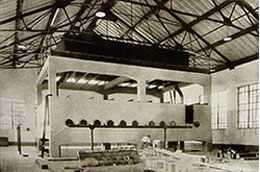
Fall 2014, Jinping Hydroelectric Dam. Along with a deafening sound from the mountains, a powerful body of water gushed into the spillway tunnel, and rushed into the Yalong River. That was an impressive image of the power of nature intertwined with the effort of human beings in constructing, with the 305-meter arch dam in the background, the highest arch dam in the world. With cheers from the crowd, the discharge test was successful. This was the “most difficult dam ever built in the world” undertaken by the hydro-power research team of Tianjin University, signifying another triumph for the hydro-power engineers.
Hydraulic engineering is one of the disciplines that has long been developed at Tianjin University. In the early days of Peiyang University, when Li Shutian, Li Yizhi and Zhang Hanying were teaching and cultivating a large number of specialists for China, the First Hydraulics Laboratory possessed a crucial place in the history of the development of the disciplines that were taught.
In the late 1900s, Germany built many hydraulics laboratories, and soon other countries followed suit. As an American engineer said, “A hydraulics laboratory is the only thing in the world that can reap benefits from a thousand times of the input”. After tests in the hydraulics laboratory, millions of money can be saved by the actual construction. Hydraulics experts, such as Li Yizhi and Li Shutian, strongly called for and supported the establishment of the first hydraulics laboratory in China.
It could be traced back to the time when the North China Water Conservancy Commission was founded that Li Yizhi and Li Shutian suggested that a river hydraulics lab be built with the indemnity paid by the Netherlands. However it was disapproved by the Republic government. In April 1931, the China Water Engineering Society, initiated by Li Yizhi and Li Shutian, was established in Nanjing, and the Appeal for the Establishment of State-owned Central Hydraulics Laboratory was approved. This was the beginning of a larger effort in building a state-owned hydraulics laboratory. The next year, Li Shutian took over the position of president of the Peiyang College of Engineering (later Peiyang University), and started to shoulder the responsibility of building a state-owned hydraulics laboratory. He and Li Zhiyi, called on the North China Water Conservancy Commission, Yellow River Water Conservancy Commission, Peiyang College of Engineering, and the Heibe School of Engineering to cooperate in establishing the first hydraulics laboratory in Tianjin. In order to engage more units, a Board of Directors was adopted, with the top executives of the participating units appointed as directors.
Fund-raising progressed smoothly after setting up the Board of Directors. Donations and support arrived and soon the amount of fund raised reached more than 400 thousand yuan. The construction of the hydraulics lab officially started in 1933. The main facilities included a reservoir, a reclaiming tank, a large testing tunnel, and high and low water tank. All the experimental instruments were imported from Germany, except for the water pump which was bought from the United Kingdom.
During the ceremony when laying the foundation stone, Li Shutian delivered a speech. He commented that “as planned, when the lab is established, if not solely for the water specialists to conduct experiments, the lab would also be of great benefit and provide a hands-on experience for the students of Peiyang and the School of Engineering.” After the lab is put into full use he continued, “apart from the purpose of sorting out the issues in the Yellow River, experiments of the Yongding River and the water reservoir project are to also be carried out.” The inauguration ceremony of the Hydraulics Lab was held on November 12 1935. After the ceremony, Li Yizhi released water that started the dissipation test of the Guanting Reservoir. Newspapers, such as The Morning Post and Shenbao gave detailed accounts of the event with headlines such as “The only device in the country, the only one in Asia”, “The One and Only Hydraulics Lab in China”.
The first hydraulics laboratory in China was established to carry out joint research and cooperation between colleges and construction entities. It was the pioneer of the industry-study university-research integration model highly advocated today.
During the War of Resistance against Japanese Aggression, the lab was deduced to a Japanese field hospital. All the historical documents and books were looted. Only valuable devices deposited at the British concession were spared the disaster. All experiments came to a standstill. After that, the First Hydraulics Laboratory of China was never rebuilt, but the deposited devices were retrieved and kept by the Tianjin Hydraulics Laboratory when Peiyang University recommenced. A trace of the First Hydraulics Laboratory therefore managed to continue at Tianjin University, and carried forward the fine traditions of the Chinese hydro-power engineers.






